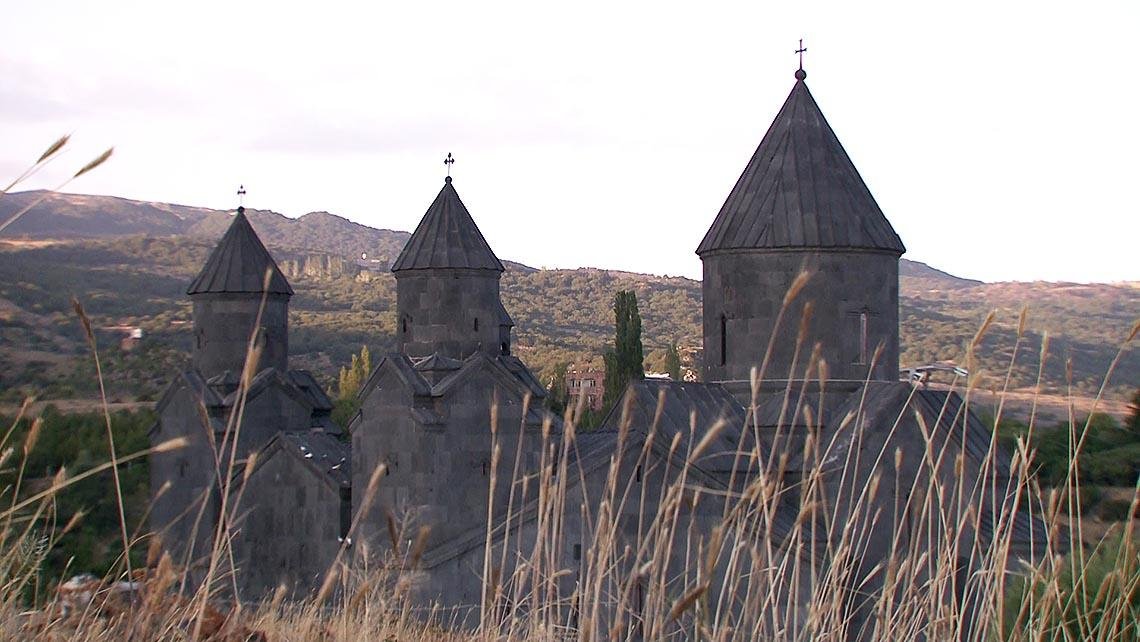
 |
Aghitu Monument and Tanahat MonasteryThe Tanahat Monastery, or as the locals call it, the Red Monastery, is located 25 km southwest of Sisian, near the village of Arevis. Stepanos Orbelyan called the monastery a “great monastery of virtues,” where numerous legends about the holy life of ascetics and lay clergy were woven. During our trip, we also presented the unique monument of the 6th-7th centuries in the village of Aghitu. |
 |
Sisian: St. Gregory the Illuminator ChurchAfter the destruction of the Syunik principality of Shaghat and the monastery by Persian troops in the 360s, the Syunik monastery became the main sanctuary of the Syunik principality and until the 9th century was the episcopal seat of Syunik and the center of the ministerial dynasty. In the 80s of the 6th century, the Syunik princess Varazdukht built the St. Gregory the Illuminator temple on the site of the ancient temple of the monastery, which is now the visiting card of Sisian. |
 |
OghbiOne of the 60 abandoned villages in Vayots Dzor is Oghbin. It is not known what the name of the settlement means or how it is explained. The village borders Azerbaijan, located about 8 km northeast of the village of Khndzorut. The only remaining witness to the abandoned village is the Oghbin church, built in 1666 and carved into the rocks.
|
 |
Martirosats MonasteryThe 13th-century rock-cut Holy Mother God Church in the village of Martiros in Vayots Dzor is the largest rock-cut architectural complex in Armenia after Geghard. It is built entirely inside Mount Nzar. The square-shaped complex consists of a vestibule, a prayer room, and a church. It is entirely carved into the rock, with only a small entrance from the outside, which was much more inconspicuous in its time. |
 |
Bovurkhan Monastery in Artsakh
Bovurkhan Monastery is located in the Martuni region of the Republic of Artsakh. It was built in the 17th century, in the historical Varanda province of Artsakh. The monastery complex was the summer residence of the Varanda meliks. In 2023, the monastery was annexed by Azerbaijan along with the Nagorno-Karabakh Republic.
The Bovurkhan Monastery Complex is under the jurisdiction of the Artsakh Diocese of the Armenian Apostolic Church.
|
 |
St. Ascension Church in Artsakh
The Church of the Holy Ascension in Berdzor is the first church in the Nagorno-Karabakh Republic to declare independence in the 20th century. It was consecrated on May 31, 1998.
The church, along with the city of Berdzor, came under the control of the Azerbaijani armed forces in 2022. Satellite photos from May 2024 show that it was completely destroyed by Azerbaijan.
The deliberate destruction of the church is a gross violation of international law and is considered a grave crime against humanity.
|
 |
Gandzasar in Artsakh
Gandzasar Monastery is located in the Martakert region of the Republic of Artsakh, near the village of Vank. Hasan Jalal Dolan, the prince of the Khachen province of Artsakh, began the construction of the St. John Church in 1216. The construction lasted 22 years.
In 2023, the monastery, along with the Nagorno-Karabakh Republic, was annexed by Azerbaijan. Gandzasar Monastery is under the jurisdiction of the Artsakh Diocese of the Armenian Apostolic Church.
|
 |
Shoshkavank in ArtsakhShoshkavank is located in the Martuni region of the Republic of Artsakh, on a mountain peak between the villages of Msmna and Khachmach. In 2023, the monastery was occupied by Azerbaijan along with the Nagorno-Karabakh Republic. Shoshkavank is under the jurisdiction of the Artsakh Diocese of the Armenian Apostolic Church. |
 |
Ulubab Monastery in ArtsakhThe village of Ulubab is in the Askeran region of the Republic of Artsakh. The village, which has a rich history, was the royal residence of Uli Pap, a descendant of the famous Hasan Jalalyan dynasty of Artsakh, and was named Ulupap or Ulubab after him. St. Gevorg of Ptkesberk is located here. In 2023, together with the Nagorno-Karabakh Republic, the monastery was occupied by Azerbaijan. The monastery of the Holy Young Children is under the jurisdiction of the Artsakh Diocese of the Armenian Apostolic Church. |
 |
Holy Mother of God Church in Khnushinak
The Holy Mother of God Church in the village of Khnushinak, Martuni region, Republic of Artsakh is a basilica built on two spans of arches. It was built in 1860, with the funds of Hayrapet Bey Dolukhanyan from Shushi. In 2023, the church was occupied by Azerbaijan along with the Republic of Nagorno-Karabakh.
The Holy Mother of God Church in Khnushinak is under the jurisdiction of the Artsakh Diocese of the Armenian Apostolic Church.
|
 |
Bri Eghtsi Monastery Complex in Artsakh
Bri Eghtsi Monastery is located in the Martuni region of the Republic of Artsakh.
It is the largest monastery in Artsakh by area. It was built in the 13th century. The monastery complex is especially famous for its walled khachkars.
In 2023, the monastery was occupied by Azerbaijan along with the Nagorno-Karabakh Republic. Bri Eghtsi Monastery in the village of Hatsi is under the jurisdiction of the Artsakh Diocese of the Armenian Apostolic Church.
|
 |
The Valley of Cross Stones in Artsakh
On the roadside of the village of Shahmasur in Artsakh is the area called the Valley of Cross-Stones, which is a medieval Armenian cemetery. It was built in the 11th-12th centuries. The number of officially certified cross-stone monuments in the territory of the Nagorno-Karabakh Republic reaches two thousand. After the occupation of the Nagorno-Karabakh Republic by Azerbaijan in 2023, their condition is unknown.
|
